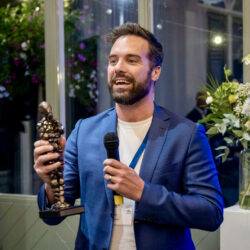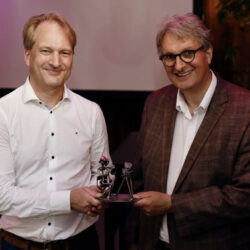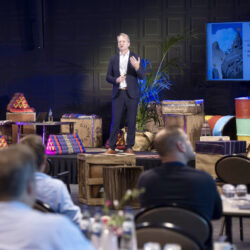Flexport’s Mathijs Slangen wins first SCM Thought Leader Award

Mathijs Slangen of Flexport was presented with the first-ever SCM Thought Leader Award at the Supply Chain Trend Dinner held on 31 August. His pitch on digital transformation received the most votes from the supply chain directors present. Slangen urged companies to keep the momentum going when it comes to digitalization and process automation: “I expect the gap between leaders and laggards to continue to widen.”
By Marcel te Lindert
The Supply Chain Trend Dinner is based around a simple concept; 11 experts from providers of supply chain management solutions and services have four minutes to answer three questions: What’s going on in the world? How is it affecting business? And what should be done about it? The experts often struggle to answer that last question in particular. Most don’t get much further than thinly disguised advice to buy their company’s solutions and services.
This year, there was an added incentive for the experts to come up with a good response: the SCM Thought Leader Award. The accolade, which looks like a cross between an Oscar and sculptor Rodin’s Le Penseur, is awarded to the pitch that receives the most votes from the supply chain executives at the dinner. But to earn the title of ‘SCM Thought Leader’ for a year, more than just factual expertise is required, according to host Martijn Lofvers from Supply Chain Media: “A true thought leader must also have the characteristics of an evangelist and an influencer. You have to know how to reach the right people so that you can make yourself heard. And you have to have a clear, thought-provoking opinion that resonates. Your message must set you apart from the rest.”
Visibility is not an end goal
Mathijs Slangen, Vice President of Sales & Marketing at Flexport, ticked all the boxes. In his winning pitch, he reflected on the very first conference he spoke at in 2011. The main themes were connectivity, end-to-end supply chain planning and big data. “That was 12 years ago. We’re still talking about those same trends nowadays. We’ve made substantial improvements in the intervening period, of course, but not the improvements we expected at that time.”
Slangen suggested two reasons for this. The first is that, when it comes to data, companies stop too soon. “Take a topic like visibility. That is often seen as an end goal. Companies think ‘I know exactly where my goods are, if they get delayed in Singapore, and why’. That’s all very handy, but it’s only half the story. What matters is what you then do with those insights. Which planner should you notify, and what action should he take? The great thing is that we’re getting more and more predictive models that tell us what to do, so we don’t have to think about that ourselves anymore.”
Digital transformation
The second reason relates to digital transformation. Slangen argued that companies want too much, too quickly. “A digital transformation strategy has three important elements: digitization, network and automation. At Flexport, we started digitizing trade and shipping flows 11 years ago. Then we spent a lot of time expanding our network. The third step is automation so that data tells us what to do. All three elements are equally important, but you can never tackle them all at once. You will have to take a phased approach.”
The need for digital transformation will continue to increase in the foreseeable future. Mathijs Slangen referred to trends such as nearshoring, sustainability and e-commerce. “I see a lot of companies that are on the right track and have started working with predictive models, for example. But I also see a lot of companies that aren’t. I expect the gap between leaders and laggards to continue to widen over the next 12 months. It will be an interesting year in which it will be important to stay ahead.”










